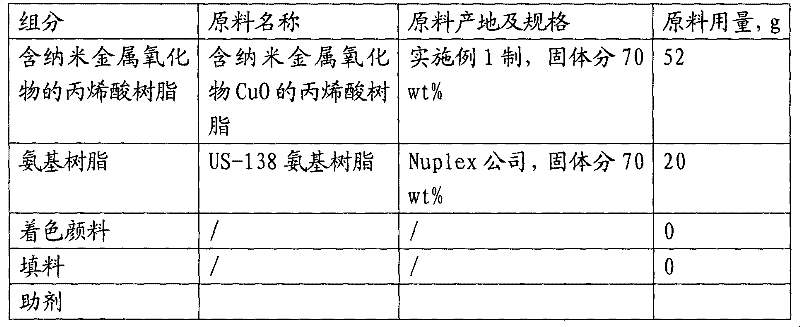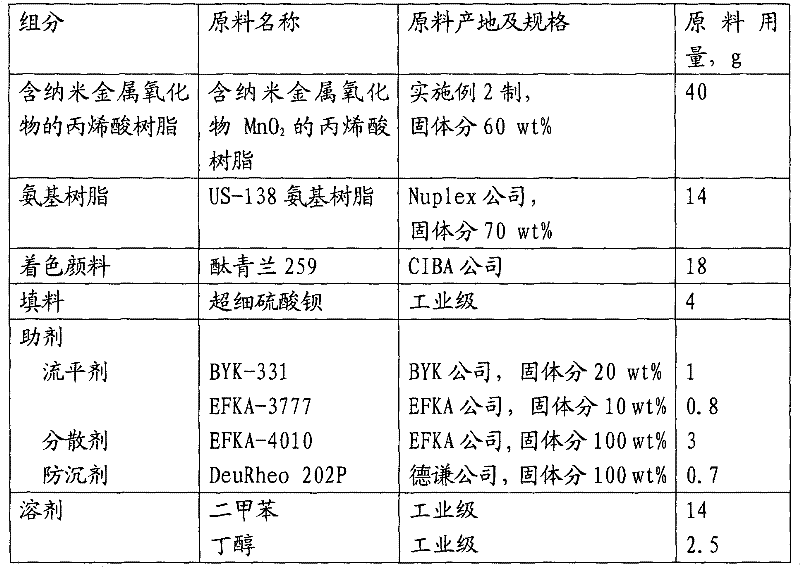Nano metal oxide-containing solvent-based vehicle thermal insulation coating
A nano-metal and thermal insulation coating technology, applied in anti-corrosion coatings, coatings, etc., can solve the problems of time-consuming, high cost, brittleness, etc., and achieve the effect of overcoming easy aggregation, taking into account anti-corrosion, and reducing absorption
- Summary
- Abstract
- Description
- Claims
- Application Information
AI Technical Summary
Problems solved by technology
Method used
Image
Examples
Embodiment 1
[0018] Embodiment 1 prepares the acrylic resin A containing nanometer metal oxide
[0019] Concrete preparation steps are as follows:
[0020] ①Preparation of nano metal oxide sol
[0021] First use ultrasonic or high-speed dispersion to disperse 100g of nano-metal oxide CuO with a particle size of 7nm in 250g of solvent butyl acetate to form a sol, then add it to a reaction vessel equipped with a condenser, a stirrer, and a thermometer, stir and After the temperature was raised to 60°C, 50g of silane coupling agent vinyltrimethoxysilane was added dropwise, and the reaction was kept under stirring for 4h to obtain the nano-metal oxide CuO sol. In the total weight of the nano-metal oxide sol, the nano-metal oxide CuO accounted for 25wt%, silane coupling agent vinyltrimethoxysilane accounts for 12.5wt%;
[0022] ②Preparation of acrylic resin A containing nano-metal oxides
[0023] Add 100 g of nano-metal oxide CuO sol and 100 g of solvent xylene prepared in step ① into a reac...
Embodiment 2
[0025] Embodiment 2 prepares the acrylic resin B containing nanometer metal oxide
[0026] Concrete preparation steps are as follows:
[0027] ①Preparation of nano metal oxide sol
[0028] It is basically the same as Example 1, the difference is: the nanometer metal oxide MnO with a particle diameter of 15nm 2 Substituting the nanometer metal oxide CuO with a particle size of 7nm; the prepared nanometer metal oxide MnO 2 In the total weight of the sol, the nanometer metal oxide MnO 2 Accounting for 25wt%, the silane coupling agent vinyltrimethoxysilane accounts for 12.5wt%;
[0029] ②Preparation of acrylic resin B containing nano-metal oxides
[0030] Add the nanometer metal oxide MnO prepared in step ① into a reaction vessel equipped with a condenser, a stirrer, a thermometer and a dropping funnel 2 Sol 100g and solvent xylene 332g, stir evenly, heat up to 140°C, add dropwise 90g styrene, 180g methyl methacrylate, 6g acrylic acid, 144g butyl methacrylate, 36g isooctyl ac...
Embodiment 3
[0032] Embodiment 3 prepares transparent solvent-based vehicle thermal insulation coating containing nanometer metal oxide
[0033] ① Coating formula
[0034] It is composed of the following components. Except for solvent, the content of each component is as follows in terms of solids: acrylic resin containing nanometer metal oxide accounts for 36.4wt%, amino resin accounts for 14wt%, coloring pigment accounts for 0wt%, and filler accounts for 0wt%. The solvent accounts for 3.04wt%, and the solvent accounts for 46.56wt% (including the solvent contained in the remaining components). The sum of the above components is 100%. The raw material consumption of each component is shown in Table 1.
[0035] Table 1
[0036]
[0037]
[0038] ②Preparation process
[0039] The transparent solvent-based vehicle heat-insulating coating containing nanometer metal oxide is prepared according to the existing technology.
PUM
| Property | Measurement | Unit |
|---|---|---|
| glass transition temperature | aaaaa | aaaaa |
| particle diameter | aaaaa | aaaaa |
| glass transition temperature | aaaaa | aaaaa |
Abstract
Description
Claims
Application Information
 Login to View More
Login to View More - R&D
- Intellectual Property
- Life Sciences
- Materials
- Tech Scout
- Unparalleled Data Quality
- Higher Quality Content
- 60% Fewer Hallucinations
Browse by: Latest US Patents, China's latest patents, Technical Efficacy Thesaurus, Application Domain, Technology Topic, Popular Technical Reports.
© 2025 PatSnap. All rights reserved.Legal|Privacy policy|Modern Slavery Act Transparency Statement|Sitemap|About US| Contact US: help@patsnap.com



